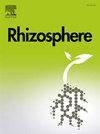Short-term continuous cropping leads to a decline in rhizosphere soil fertility by modulating the perilla root exudates
IF 3.4
3区 生物学
Q1 PLANT SCIENCES
引用次数: 0
Abstract
Continuous cropping obstacles are a prevalent issue in agricultural production worldwide. However, the key factors leading to these obstacles differ among various crops. This study utilized high-throughput sequencing and metabolomics to assess the community structure of microbes and the types and abundance of metabolites in rhizosphere soil after different continuous cropping years of Perilla frutescens L. Britt. (perilla). The results indicate that differential metabolites in soils of varying continuous cropping years are primarily associated with pathways for cellular lipid formation, oxidative stress responses, and energy metabolism. These findings suggest that the changes in soil composition over time are linked to specific biological processes related to lipid formation, oxidative stress, and energy metabolism. The relative abundance of beneficial bacteria in the soil, such as Sphingomonas, Gemmatimonas, and Blastococcus, decreased significantly (p < 0.05), while harmful fungi, such as Neocosmospora and Didymella, increased in response to the increase in continuous cropping years (p < 0.05). The symbiotic network between bacteria and fungi has become less dense and stable after continuous cropping. Enzymatic activities in rhizosphere soil decreased significantly (p < 0.05). Soil organic matter, total nitrogen, total phosphorus, total potassium, available phosphorus, and available potassium declined significantly (p < 0.05). Pearson correlation analysis identified 10 differential secondary metabolites that were closely related to the relative abundance of key microorganisms. Among them, cinnamic acid and flavonoid compounds are key factors leading to changes in microbial diversity, and they can regulate the microorganisms-soil- plants interactions. In summary, this study provides a novel scientific explanation for how continuous cropping can reduce soil fertility and a theoretical basis for subsequent cultivation strategies of perilla.
短期连作通过调节紫苏根部渗出物导致根瘤土壤肥力下降
连作障碍是全球农业生产中普遍存在的问题。然而,导致这些障碍的关键因素因作物而异。本研究利用高通量测序和代谢组学方法,评估了紫苏(Perilla frutescens L. Britt.(紫苏)的群落结构以及代谢物的种类和丰度。结果表明,不同连作年份土壤中代谢物的差异主要与细胞脂质形成途径、氧化应激反应和能量代谢有关。这些发现表明,土壤成分随时间的变化与脂质形成、氧化应激和能量代谢相关的特定生物过程有关。土壤中的有益细菌,如Sphingomonas、Gemmatimonas和Blastococcus的相对丰度显著下降(p <0.05),而有害真菌,如Neocosmospora和Didymella则随着连作年数的增加而增加(p <0.05)。连作后,细菌和真菌之间的共生网络变得不那么密集和稳定。根瘤土壤中的酶活性显著下降(p < 0.05)。土壤有机质、全氮、全磷、全钾、可利用磷和可利用钾显著下降(p < 0.05)。通过 Pearson 相关性分析发现,有 10 种差异次生代谢物与关键微生物的相对丰度密切相关。其中,肉桂酸和黄酮类化合物是导致微生物多样性变化的关键因素,它们可以调节微生物-土壤-植物之间的相互作用。总之,这项研究为连作如何降低土壤肥力提供了新的科学解释,并为紫苏的后续栽培策略提供了理论依据。
本文章由计算机程序翻译,如有差异,请以英文原文为准。
求助全文
约1分钟内获得全文
求助全文
来源期刊

Rhizosphere
Agricultural and Biological Sciences-Agronomy and Crop Science
CiteScore
5.70
自引率
8.10%
发文量
155
审稿时长
29 days
期刊介绍:
Rhizosphere aims to advance the frontier of our understanding of plant-soil interactions. Rhizosphere is a multidisciplinary journal that publishes research on the interactions between plant roots, soil organisms, nutrients, and water. Except carbon fixation by photosynthesis, plants obtain all other elements primarily from soil through roots.
We are beginning to understand how communications at the rhizosphere, with soil organisms and other plant species, affect root exudates and nutrient uptake. This rapidly evolving subject utilizes molecular biology and genomic tools, food web or community structure manipulations, high performance liquid chromatography, isotopic analysis, diverse spectroscopic analytics, tomography and other microscopy, complex statistical and modeling tools.
 求助内容:
求助内容: 应助结果提醒方式:
应助结果提醒方式:


